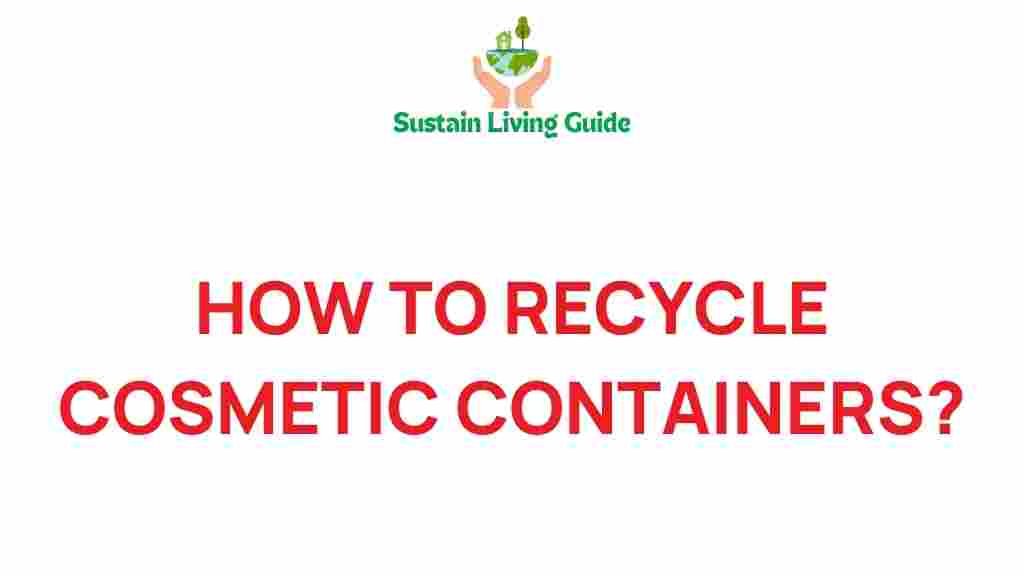Recycle: Unlocking the Secrets to Effective Cosmetic Container Recycling
In today’s world, sustainability is more important than ever. With the rising awareness of environmental issues, individuals are looking for ways to minimize their ecological footprint. One often-overlooked area is the recycling of cosmetic containers. Many beauty products come in packaging that can be recycled, yet a vast majority end up in landfills. In this guide, we will explore how to recycle cosmetic containers effectively, ensuring that you contribute to a greener planet while also decluttering your beauty stash.
Why Recycling Cosmetic Containers Matters
Recycling cosmetic containers is crucial for several reasons:
- Environmental Impact: By recycling, you reduce the amount of waste in landfills, which can take hundreds of years to decompose.
- Resource Conservation: Recycling helps conserve natural resources by reusing materials instead of extracting new ones.
- Energy Savings: The recycling process typically uses less energy compared to manufacturing new products from raw materials.
Common Materials in Cosmetic Containers
Before diving into the recycling process, it’s essential to know the materials commonly used in cosmetic packaging:
- Plastic: Most cosmetic containers are made from various types of plastic, such as PET, HDPE, and PP.
- Glass: Many high-end skincare products are packaged in glass, which is recyclable and reusable.
- Metal: Some products come in aluminum or tin containers, which can also be recycled.
- Cardboard: Outer packaging, like boxes, is typically made from cardboard and can be recycled easily.
Step-by-Step Process to Recycle Cosmetic Containers
To recycle cosmetic containers effectively, follow these simple steps:
1. Check Local Guidelines
Before recycling, check your local recycling guidelines. Different municipalities have varying rules regarding what can and cannot be recycled. Many areas have specific guidelines for cosmetic containers, so it’s essential to be informed. You can find your local recycling rules by visiting Earth911.
2. Clean Your Containers
Most recycling facilities require containers to be clean and free of residue. Follow these steps to prepare your cosmetic containers for recycling:
- Empty the container: Ensure that the container is as empty as possible. Use a spatula or your fingers to scrape out any remaining product.
- Rinse: Rinse the container with warm water to remove any residue. A small amount of dish soap can be used for stubborn residues.
- Dry: Allow the containers to air dry completely before proceeding.
3. Sort by Material
Once your containers are clean and dry, sort them based on their material type. This step is crucial because different materials are processed differently at recycling facilities. Group your containers into:
- Plastic
- Glass
- Metal
- Cardboard
4. Check for Recycling Symbols
Look for recycling symbols on the bottom of your containers. These symbols indicate the type of plastic and whether it is accepted in your local recycling program. The most common symbols you’ll find are:
- 1 (PETE): Usually accepted in most recycling programs.
- 2 (HDPE): Also commonly accepted.
- 5 (PP): Sometimes accepted; check local guidelines.
5. Recycle or Upcycle
Once sorted, you can either recycle the containers or consider upcycling them. Upcycling is a creative way to repurpose materials instead of throwing them away. Here are a few ideas:
- Glass jars: Use them for storage, such as holding spices or small craft items.
- Plastic containers: Consider using them for organizing your desk or as plant pots.
- Cardboard boxes: Transform them into gift boxes or organizers.
Troubleshooting Common Recycling Issues
While recycling cosmetic containers can be straightforward, you may encounter some challenges. Here’s how to troubleshoot common issues:
Problem: Container Won’t Fit in Recycling Bin
Solution: If your container is too large, check if your local recycling program has a drop-off location for larger items. Alternatively, consider breaking down the container if possible, such as removing the cap from a plastic bottle.
Problem: Product Residue Remains
Solution: If you’re having difficulty removing residue, try soaking the container in warm soapy water for a few hours. This method often loosens stubborn products.
Problem: Unsure About Material Type
Solution: If you’re unsure about the material, check the recycling symbol on the bottom. If it’s not clear, research online or contact your local recycling center for guidance.
Conclusion
Recycling cosmetic containers is a simple yet impactful way to contribute to a sustainable future. By following the steps outlined in this guide, you can ensure that your beauty products don’t end up in landfills. Remember to check local guidelines, clean and sort your containers, and consider upcycling as an alternative. Every small action counts, so start recycling today and inspire others to do the same!
For more tips on sustainability and recycling, check out our eco-friendly living section for additional resources and information.
This article is in the category Waste and created by SustainLivingGuide Team
